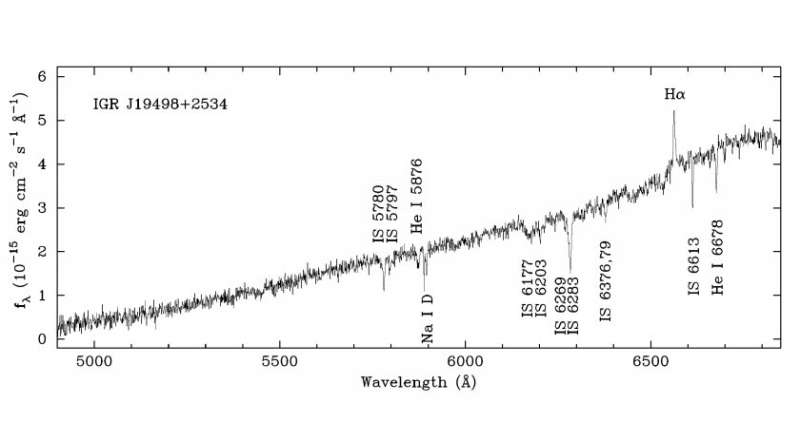April 30, 2019 report
AX J1949.8+2534 is a supergiant fast X-ray transient, observations confirm

Based on the results from a set of telescopes, astronomers detected X-ray variability of the source AX J1949.8+2534 and confirmed that the object is a supergiant fast X-ray transient (SFXT). The finding is reported in a paper published April 22 on the arXiv pre-print repository.
SFXTs are a class of high-mass X-ray binaries (HMXBs) with supergiant companions. They showcase significant X-ray flaring activity, experiencing outbursts with very fast rise times and typical durations of a few hours that are associated with supergiant stars.
Located most likely some 22,800 light years away from the Earth, AX J1949.8+2534 (AX J1949 for short) was discovered almost two decades ago by the ASCA Galactic Plane Survey. Previous X-ray observations of this source suggested that it is a high-mass X-ray binary (HMXB) with a Be spectral-type companion (BeHMXB) or an SFXT. However, studies published in 2017, which reported the detection of bright flares in AX J1949, favored the SFXT scenario.
Now, a team of astronomers led by Jeremy Hare of University of California, Berkeley, have published the results of new observations of AX J1949 using NASA's Swift, Chandra and NuSTAR space telescopes. The observational campaign allowed them to uncover more details about the properties of this source, which could be decisive in determining its true nature.
"In this paper, we report on Neil Gehrels Swift-XRT, Chandra, and NuSTAR legacy observations of the SFXT candidate AX J1949," the paper reads.
The observations revealed that AX J1949 exhibits rapid X-ray variability on kilosecond timescales. The study emphasized that a large number of still unidentified sources observed by ESA's INTEGRAL spacecraft that showcase such variability, have been classified as SFXTs.
Moreover, the researchers found that the AX J1949 binary contains an early B-type supergiant of the Ia luminosity class, which, according to the paper, confirms the SFXT nature of the studied object.
"We find that an early B-type Ia is the most likely spectral type and luminosity class of the star, making AX J1949 a new confirmed member of the SFXT class," the astronomers concluded.
They added that in general, early supergiant B-type stars, have been found so far in about 40 percent of the known SFXT systems.
Additionally, the observations allowed the authors of the paper to make new calculations regarding the distance to AX J1949 and to estimate the reddening of the system. They found that the binary is located most likely between 22,800 and 26,000 light years away, while its reddening is at a level of about 8.5 to 9.5.
More information: Jeremy Hare et al. Chandra, MDM, Swift, and NuSTAR observations confirming the SFXT nature of AX J1949.8+2534. arXiv:1904.09762 [astro-ph.HE]. arxiv.org/abs/1904.09762
© 2019 Science X Network



















